Snakes – with their diverse species and intriguing adaptations – have been captivating humans for centuries. Do you know snakes are present in nearly every corner of the globe? From the vibrant colors of the corn snake to the majestic beauty of the ball python, each species has its own:
- Unique characteristics
- Habitat preferences
- Food requirements
- Interact with humans much differently than warm-and-fuzzy pets do.
However, not all these captivating creatures are suitable for novice snake keepers. As a beginner, it’s crucial to start your snake-keeping journey with a species that is forgiving of minor mistakes and easier to handle. That’s where the docile and easy-to-care snake species come into play. Whether you’re a first-time snake owner or someone looking to expand their scaly family, these snake species will make the perfect companions for you. These snakes have earned their reputation for being friendly, low-maintenance, and adaptable, making them ideal companions for beginners.
So, without further ado, let’s jump right in.
11 Best Pet Snakes for Beginners
There are roughly over 4000 species of snakes in the world, so would-be snake owners have a number of options available to them. However, the vast majority of these species are difficult to care for and best left to experienced keepers.
Beginners should stick to those species that are docile, easy to feed and remain relatively small. Additionally, beginners should only acquire snakes that were born and bred in captivity, as wild-caught snakes often present a number of challenges.
To assist novice pet parents in their decision-making process – here’s some introductory information about the best snake species. While this can help narrow down choices, it’s crucial to thoroughly research and educate oneself before making a purchase.
Some of the best species for beginners include the following:
- Corn snakes
- Ball pythons
- Rosy boas
- Garter snakes
- Brown snakes
- Kingsnakes
1. Corn Snakes
The corn snake – see article’s main picture – (Pantherophis guttatus) has been one of the most popular species among snake keepers since people began keeping snakes as pets. Corn snakes are typically docile, hardy and they rarely present feeding difficulties or health problems. Corn snakes do require a rodent-based diet, but they remain relatively small (most individuals are about 4- to 6-feet-long).
2. Ball Pythons
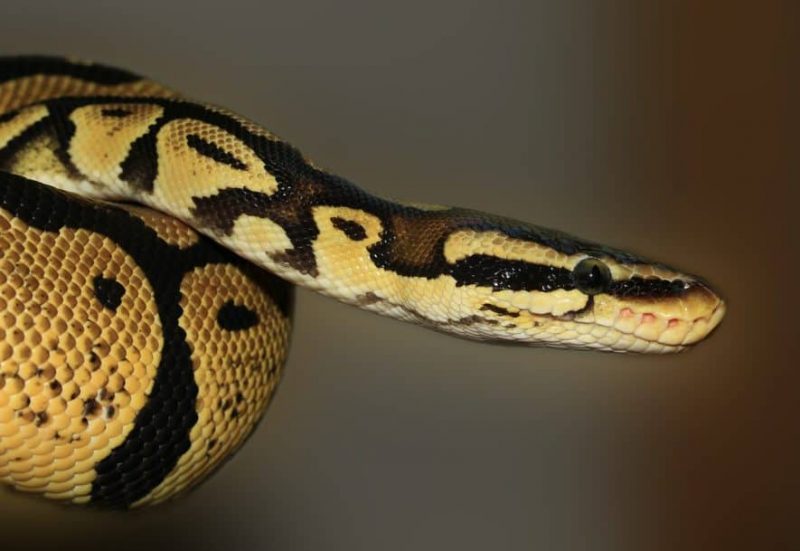
Ball pythons (Python regius) are likely the best python for beginning snake keepers to maintain. They are typically quite calm, who rarely bite. Instead, they prefer to bury their head in their coils when frightened. Captive bred individuals are typically very easy to feed, and they are available in a wide variety of color varieties, including albino, hypomelanistic and others.
3. Rosy Boas
https://www.instagram.com/p/BfClInylDHA
Unfortunately, rosy boas (Charina trivirgata) are not as commonly seen in pet stores as corn snakes or ball pythons are. Nevertheless, they make very good pets, especially for beginners. Rosy boas are very attractive, and they are generally undemanding captives. Most are quite tame and don’t present problems at feeding time, once they’ve begun taking food regularly.
4. Garter Snakes
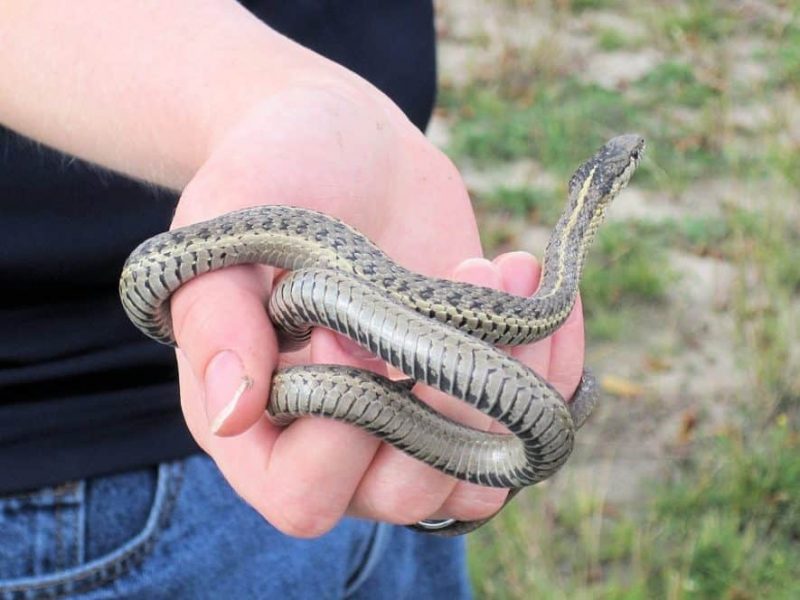
Garter snakes (Thamnophis spp.) are familiar to almost everyone who’s spent time outdoors in North America, and it turns out that they often make good pets too. There are a number of garter snake species on the market, but most are relatively similar. They primarily differ in terms of color pattern and food habits. Common garter snakes, for example, will typically live on a fish-based diet, while others prefer to eat worms.
5. House Snakes
House snakes (Lamprophis spp.) are interesting snakes from Africa, who make fantastic pets. House snakes usually don’t bear bold colors or patterns, but they have very mild, easy-going temperaments and are usually very easy to feed. Additionally, if you’d like to try breeding snakes, house snakes are one of the best choices for beginners.
6. Ringneck Snakes
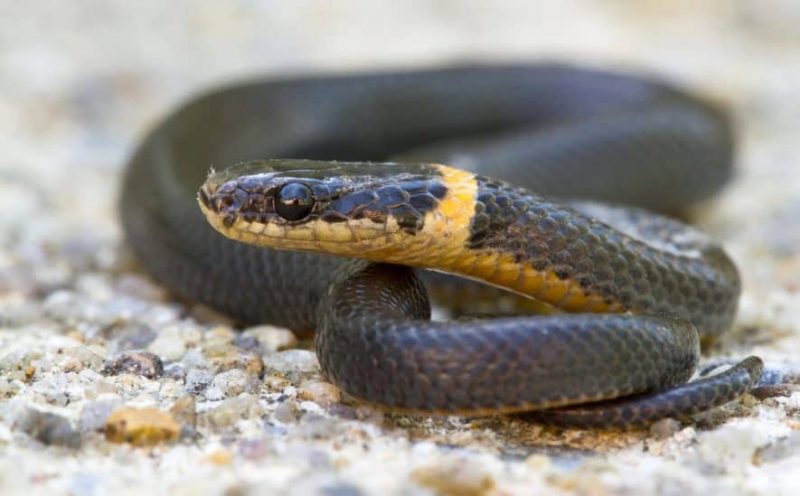
Ringneck snakes (Diadophis punctatus) are very small snakes, who are generally brown to black, with a yellow to red belly and matching ring around their neck. They typically feed on elongate ectotherms, which means keepers can usually feed them an earthworm-based diet. Ringneck snakes do have a mild venom, but only the largest individuals can effectively bite humans.
7. Brown Snakes
https://www.instagram.com/p/BofPx30BO8y
Brown snakes (Storeria dekayi) are very commonly encountered around human habitation, so it shouldn’t be surprising that they also make good pets. Small and mild-mannered, brown snakes are usually a great choice for beginners, and they can subsist on a diet of earthworms, snails, and slugs. It may, however, be difficult to find captive bred individuals on the market.
8. Green Snakes
https://www.instagram.com/p/BlaiN8dguxq/
Green snakes will thrive on an insect-based diet.
There are two species of green snake that are available to hobbyists: the smooth green snake (Opheodrys vernalis) and the rough green snake (Opheodrys aestivus). Both make good pets, remain pretty small and will thrive on an insect-based diet. However, while they are rarely aggressive, they can become stressed if handled too much.
9. Water Snakes
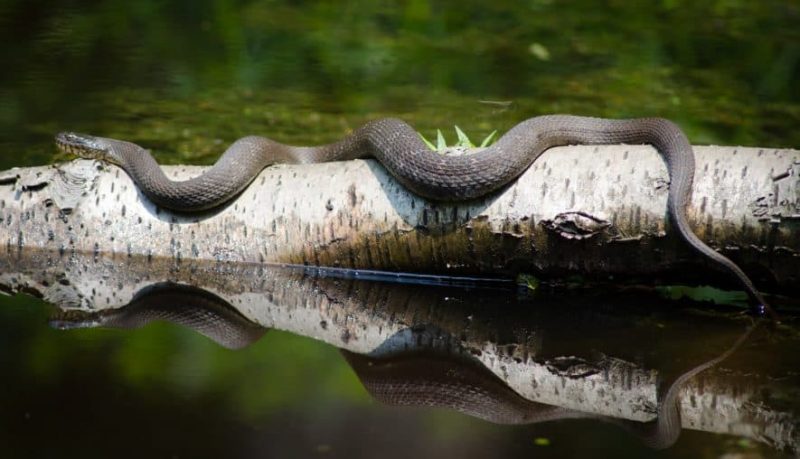
Water snakes (Nerodia spp.) aren’t especially popular among snake keepers, as they require relatively complex habitats, and they often have foul temperaments. Nevertheless, water snakes are occasionally quite attractive, they reach moderate yet manageable sizes, and they are easy to feed. Most water snakes consume frogs or fish.
10. Children’s Pythons
The children’s python (Antaresia childreni) is a small Australian species that is sometimes kept as a pet. Children’s pythons are normally rather tame, although young individuals may be nippy. Young children’s pythons can be difficult to feed, so beginners should try to acquire a juvenile or adult specimen to avoid these problems.
https://www.instagram.com/p/BkllK4Vjvp-/
11. Sand Boas
Sand boas (Eryx spp.) are small boas who are much easier to maintain than some of their larger cousins are. Most sand boas are relatively tame, and they are typically easy to feed. Some species are quite colorful and attractive, but they do spend most of their time buried beneath the substrate. There are several species of sand boa on the market, but Kenyan sand boas (Eryx colubrinus) are the most readily available.
12. Kingsnakes
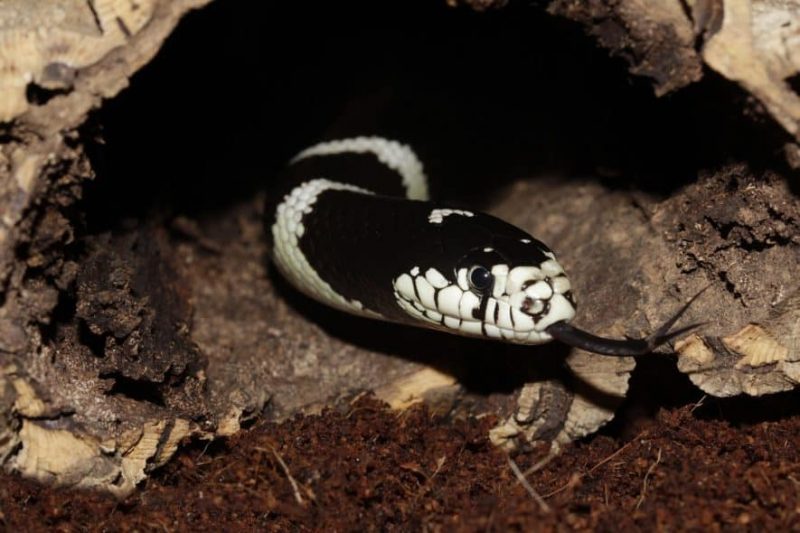
There are a number of different kingsnakes (Lampropeltis spp.) available to snake keepers, and most make pretty good pets. A few kingsnake species grow large enough to present challenges, but the vast majority remain less than 4 feet long. Kingsnakes typically eat rodents in captivity, but wild individuals consume just about anything they encounter, including snakes, lizards, rodents, frogs and other animals.
Snakes To Avoid As First-Time Owners
Many snakes are bad for keeping as pets. They’re the worst pet snakes for beginners because they’re unfriendly and very aggressive, and they like to bite humans. Also, some snakes need special conditions that are hard to provide in captivity. Here are ten snake species that make the worst pets.
Reticulated Python
Reticulated Pythons are massive snakes that can grow as long as 20 feet or more (max recorded length is ~33 feet), just like African Rock Pythons. You need a lot of room for them, and they don’t like people touching them. They get spooked easily. Here are some reasons why you should never get a Reticulated Python as a pet:
- They’re too big for most homes. You’d have to spend a fortune on a cage for them.
- They’re not friendly or cuddly. They don’t care about their owner at all.
- They only eat live food. You’d have to buy them live rats, smaller primates, chickens, rabbits, or pigs to feed them.
- They’re at the top of the food chain & are dangerous. They can kill you if they want to.
- They do not remain healthy throughout their life. They get all kinds of problems like breathing trouble, skin issues, blockages, bugs, and injuries from their food.
So, do yourself a favor and don’t get a Reticulated Python. They’re more trouble than they’re worth.
Green Anaconda
Green Anacondas are giant snakes that live in marshes, swamps, and slow-moving streams. They’re not fit pets for anyone, especially beginners as they need proper veterinary care & advanced husbandry techniques. Here are some reasons why you should steer clear of Green Anacondas as pets:
- They’re very heavy – up to 550 pounds. They need a lot of food in captivity, such as live rodents, small birds, etc.
- They’re very messy. They need a large water tank that you have to clean often, because they poop and pee in the water.
- They’re very aggressive. They can bite or squeeze you anytime, especially if they feel threatened or hungry.
- They’re very tough to care for. They often have parasites and bacteria that can harm them or you, such as salmonella or mites.
Green Anacondas can live in captivity, but they’re not the best snakes to keep as pets.
African Rock Python
African Rock Pythons are huge snakes that can grow up to 20 feet. They’re native to Africa and prefer warm and humid habitats. They’re not good pets for beginners or anyone else because:
- They’re very aggressive and moody. They can be dangerous, especially if you have kids. They have a previous history of attacking humans & can bite or squeeze you if they feel scared or annoyed.
- They need a lot of food. The bigger they get, the more they eat.
- They get sick easily. They often have infectious diseases and parasites. External parasites can easily attack them even if they’re born in captivity.
- They have breathing problems and can get pneumonia & other respiratory disorders. When they get sick, they don’t recover quickly.
Boa Constrictors
Boa constrictors are bad pets for anyone. They’re big snakes that can grow up to 13 feet long. They kill their prey by wrapping their body around them and squeezing them. They get their name from their hunting method.
- You should never go near Boa constrictors when they’re eating, because they might think you’re food. They squeeze whenever they feel scared or excited by something.
- Boa constrictors are dangerous for kids, because they can overpower them easily. They’re killers that don’t care about you or anyone else.
- Boas can swallow anything they catch, like birds, lizards, rodents, squirrels, or bats. They have jaws that can stretch wide enough to swallow large prey as a whole.
- Boa constrictors are not friendly or loyal. They can hurt or kill you, even if you feed and care for them.
Below you can see the video where a Boa Constrictor attacked its owner.
https://www.youtube.com/watch?v=T4UNEpBI4n0
Flying Snakes
Flying snakes (Chrysopelea) are nervous animals who don’t like handling because it makes them stressed. Flying snakes are active during the day, so, keeping them as pets is not fun. Flying snakes are imperfect pets for anyone because:
- Feeding them is hard because they prefer eating lizards, smaller snakes, frogs, mice, and rats.
- They don’t like living in captivity. They prefer living in the wild, where they can hunt from tree to tree.
- The other reason Flying Snakes are bad to keep as pets is that they are mildly venomous. They have fangs at the back of their mouth that they use to inject venom. When they feel scared, they bite. Although non-fatal, the bites from these snakes cause pain and swelling.
Here’s a case study of a student bitten by a flying snake.
Although flying snakes don’t need much care, they’re not fit to keep as pets.
Frequently Asked Questions
Are Snakes Good Pets?
The answer to our primary question is a qualified “yes,” depending on your definition of “pet.”
Let me explain:
Snakes will not interact with you in the same way that a dog does. They’ll never fetch your slippers nor want to accompany you on a trip to the park. They won’t bond with you emotionally or become a lifelong friend in the same way canines and cats may.
In actuality, snakes are more akin to birds or fish. Some tolerate occasional interaction, making them a bit like a cockatiel or similar bird, while others would prefer if you never touched them. Such snakes are a lot like pet fish. They’re certainly interesting and rewarding animals to live alongside, but you won’t directly interact with them much.
But, snakes also exhibit a number of advantages over dogs, cats, and other traditional pets. For example, your snake will never become bored, frustrated or lonely if you don’t pay him enough attention. Your snake won’t miss you while you are gone, nor will he require a large yard – he’ll live almost entirely inside his habitat.
Snakes are also much cheaper to feed than dogs or cats of similar size are, as their cold-blooded metabolisms operate at only a fraction of the speed that a dog’s or cat’s does. And although sick or injured snakes will require veterinary care, they won’t need regular vaccinations or checkups.
So, while snakes may not be affectionate companions who become members of your family, many make very rewarding pets.
What About Those Teeth? Are Any Pet Snakes Friendly?
One of the leading reasons that would-be snake owners are reluctant to acquire a pet snake is the fear of being bitten. This is certainly understandable, as nobody wants a pet that greets them with a mouth fall of sharp teeth and snapping jaws.
Fortunately, there are a number of snake species – including several that make good pets – which are typically regarded as docile and uninclined to bite. But, you can never guarantee that a snake won’t bite, and even the tamest individuals can have bad days.
Nevertheless, the following species are typically unlikely to react adversely to being handled:
- Ball pythons
- Rosy boas
- Brown snakes
- Green snakes
Note that bites from small snakes (those less than about 3 feet long or so) rarely cause serious injuries. In fact, a run-in with a rose bush will cause much more pain than a small snake bite will. Most small snake bite wounds will heal in a day and require little first aid aside from a bit of warm soapy water.
Are Snakes Hard To Take Care Of?
If you want a snake as a pet, you should know that some snakes are easier to take care of than others. It all depends on what kind of snake it is and what it needs to be happy and healthy. You should do your homework and find out as much as you can about the snake you like before you bring it home.
Snakes can live for a long time, so you have to be ready to commit to them for years. You can ask the pet store staff for advice and tips on how to care for your snake, and also check out some books and websites about it.
The most important thing is to make your snake feel at home by creating a similar environment to where it comes from. Snakes live in different places in the wild, like grasslands, swamps, forests, or deserts. You have to find out what your snake prefers and provide the right temperature, humidity, and food for it.
Easiest Snakes To Take Care Of
Snakes are fascinating creatures, but they can also be intimidating and challenging to care for. Some snakes are large, aggressive, or have special dietary or environmental needs that can make them unsuitable. Luckily, there are also plenty of snakes that are easy to take care of. These snakes are usually small, docile, and have simple requirements. The leading factors which determine how easy to take care of a snake are:
- Temperament: Some snakes are more docile and friendly than others, and will tolerate handling better. A snake that is aggressive, defensive, or prone to biting or musking is not ideal for you.
- Size: Smaller snakes (2-6 feet) are easier to handle and house than larger ones, and they also need less food and space. You don’t want a snake that can grow too big for your enclosure or your comfort level.
- Feeding: Some snakes are more willing to eat frozen/thawed prey items, which are safer and more convenient than live ones. Having a snake that is picky, fussy, or refuses to eat regularly can be hard to take-care.
- Housing: Some snakes have simpler requirements for their enclosure, such as temperature, humidity, lighting, substrate, and enrichment. On the other hand, a snake that needs a complex or expensive setup that is hard to maintain.
Based on these factors, here are some examples of pet snake species that fit the bill:
- Corn Snake
- Ball Python
- Rosy Boas
- Children Pythons
Small Pet Snakes That Stay Small
Several snake species usually remain relatively small (less than 3 feet in length). A few of the most notable examples include:
- House snakes
- Ringneck snakes
- Green snakes
- Brown snakes
- Sand boas
- Garter snakes
For a variety of reasons, small snakes generally make better pets than large snakes do.
For example, snakes will live most of their lives inside an enclosure of some type. And while snakes don’t require as much space as many other animals do, their space needs are not insignificant. This means you must make sure your home is big enough for a sufficiently spacious snake cage.
Garter Snake are pretty common in North America, they also make good pets.
What Pet Snakes Are Least Likely To Bite?
One of the leading reasons that would-be snake owners are reluctant to acquire a pet snake is the fear of being bitten. This is certainly understandable, as nobody wants a pet that greets them with a mouth fall of sharp teeth and snapping jaws.
Fortunately, there are a number of snake species – including several that make good pets – which are typically regarded as docile and uninclined to bite. But, you can never guarantee that a snake won’t bite, and even the tamest individuals can have bad days.
Nevertheless, the following species are typically unlikely to react adversely to being handled:
- Ball pythons
- Rosy boas
- Brown snakes
- Green snakes
Note that bites from small snakes (those less than about 3 feet long or so) rarely cause serious injuries.
Pet Snakes That Don’t Eat Mice
Aside from concerns relating to body size or temperament, diet is another roadblock that prevents some people from keeping a snake as a pet. The majority of pet snake species require a rodent-based diet, which many people find upsetting.
This causes many would-be keepers to wonder if there are snakes that can survive eating other types of foods. Unfortunately, all snakes are carnivores, who require other animals for food. However, some pet snakes don’t require mice or other mammals for food.
Some species, for example, can subsist on insects and other invertebrates, and a few species will live long healthy lives on a diet of frogs or fish. A few such species are detailed below:
- Garter snakes
- Water snakes
- Ringneck snakes
- Brown snakes
- Green snakes
Ringneck snakes will make great small pet snakes.
Do Snakes Bound With Their Owners?
Snakes don’t have the brain power to feel human emotions like love and affection. They don’t care about humans like dogs or cats do. They also can’t show their feelings with their faces or their bodies because they don’t have enough muscles or eyelids.
Some snake owners think that their snake knows them and like them more than other people. But why is that?
Some scientists think that it’s because of ‘classic conditioning’. That’s when a human or an animal learns to react in a certain way to something.
So Which Specie You Should Own?
As you can see, snakes – at least some species – can make very rewarding pets.
You just have to make sure that you understand what to expect and select a species that is suitable to your living situation and skill level. It’s also important that you learn as much as you can about the species you choose. This will allow you to give your pet the best life possible.
Of course, this doesn’t represent a comprehensive list of the snakes that make good pets – there are many others that do too. Let us know which snakes you think we missed in the comments below and be sure to share this article with your friends if you found it helpful.

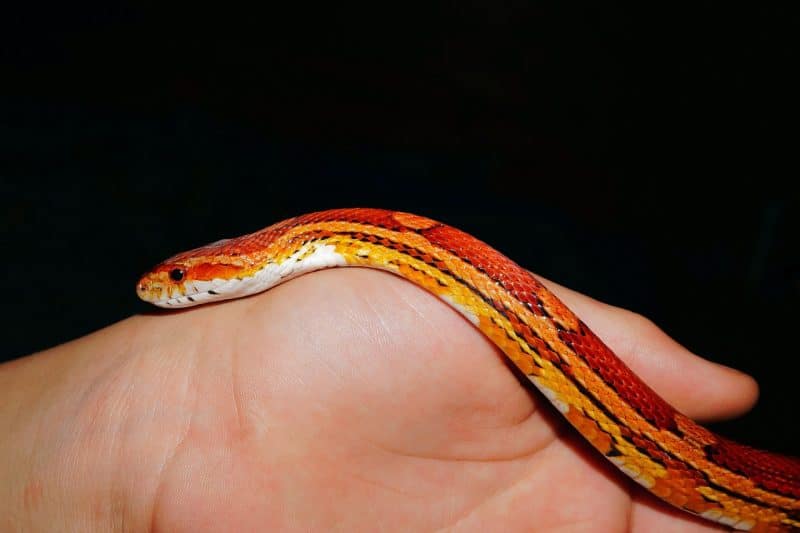
51 Comments
This is a very informative post! I’ve always been fascinated by snakes, but I never considered them as pets because of their unique needs. It’s great to know that some species can make great pets if their housing and dietary requirements are met. I look forward to reading more about the different species and their specific needs. Thanks for sharing!
Hi, I’ve heard things about dumirils boas possibly being good for a first or second pet snake. I really wouldn’t mind feeding it rats or giving it a large enclosure. Also, are they able to live in a bioactive enclosure? Thanks 😀
Yes, Dumeril’s boas make great first or second-pet snakes. They are relatively easy to care for and can be fed frozen/thawed rats or mice of appropriate sizes.
Adding a large enclosure with some hiding places is essential as they like to explore their environment and form secure hide spots.
As for living in a bioactive enclosure, that is possible as long as the enclosure is properly set up and maintained so that the environment is kept safe and healthy for them.
Make sure to use appropriate substrate and plants, as well as provide enough humidity and heat.
If you have any other questions about keeping dumeril’s boas, feel free to ask! Good luck and happy herping! 🙂